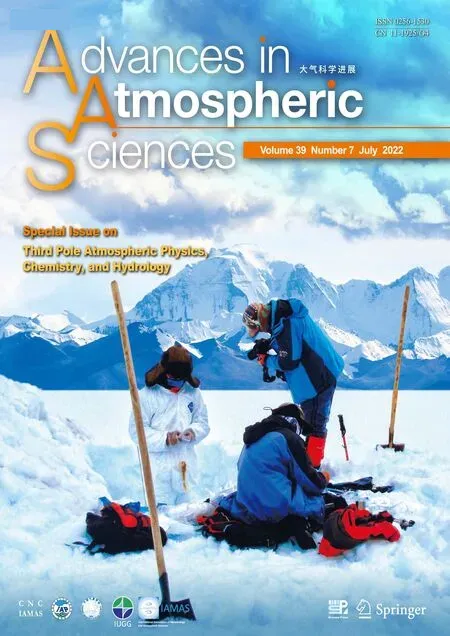Electronic Supplementary Material to:The Warming of the Tibetan Plateau in Response to Transient and Stabilized 2.0°C/1.5°C Global Warming Targets*
Jintao ZHANG,Qinglong YOU,Fangying WU,Ziyi CAI,and Nick PEPIN
1Institute of Atmospheric and Oceanic Sciences,Fudan University,Shanghai 200438,China
2Chinese Academy of Meteorological Sciences,China Meteorological Administration,Beijing 100081,China
3Innovation Center of Ocean and Atmosphere System, Zhuhai Fudan Innovation Research Institute, Zhuhai 518057,China
4CMA-FDU Joint Laboratory of Marine Meteorology,Shanghai 200438,China
5School of Environment,Geography,and Geosciences,University of Portsmouth,Portsmouth PO1 3HE,U.K

Fig.S1.Spatial patterns of seasonal mean near-surface air temperature changes on the TP.Similar to Fig.4,but for seasonal changes:(a-f) depict the summer half-year and (g-l) the winter half-year.A white mask in (a-l) is applied for areas where changes are not statistically significant according to the Wilcoxon Rank Sum test (α=0.05).The difference between the results derived from transient simulations and stabilized simulations are displayed in (m-p):(m,o):1.5°C scenario versus the reference period;(n,p):2.0°C scenario versus the 1.5°C scenario;(m-n) for the summer half-year and (o-p) for the winter half-year.“Transient”refers to the averaged results from the RCP8.5 and RCP4.5 simulations,whereas“Stabilized”refers to the low-warming simulations.Hatching in (m-p) is applied for areas where the differences are statistically significant according to Wilcoxon Rank Sum test (α=0.05).

Fig.S2.Elevation profiles of factors influencing seasonal temperature changes on the TP.Similar to Fig.7,but for the summer halfyear mean changes.Changes in surface temperature (dTs) and the seven decomposition terms given in Eq.1,as well as changes in near-surface air temperature (dTas) are displayed (see legend).(a-d) 1.5°C scenario versus the reference period.(e-h) 2.0°C scenario versus the reference period.(i-l) 2.0°C scenario versus 1.5°C scenario.Panels (a),(e),and (i) are the transient responses derived from the RCP8.5 scenario;Panels (b),(f),and (j) are the transient responses derived from RCP4.5 simulation;Panels (c),(g),and (k) are stabilized responses derived from the low-warming simulation;Panels (d),(h),and (l) are the differences between transient and stabilized response,among them,“Transient”refers to the averaged results from RCP8.5 and RCP4.5 simulations,whereas“Stabilized”refers to the low-warming simulations.

Fig.S3.Elevation profiles of factors influencing seasonal temperature changes on the TP.Similar to Fig.7,but for the winter halfyear mean changes.Changes in surface temperature (dTs) and the seven decomposition terms given in Eq.1,as well as changes in near-surface air temperature (dTas) are displayed (see legend).(a-d) 1.5°C scenario versus the reference period;(e-h) 2.0°C scenario versus the reference period;(i-l) 2.0°C scenario versus the 1.5°C scenario.Panels (a),(e),and (i) are the transient responses derived from the RCP8.5 scenario;Panels (b),(f),and (j) are the transient responses derived from the RCP4.5 simulation;Panels (c),(g),and (k) show the stabilized responses derived from the low-warming simulation;Panels (d),(h),and (l) show the differences between the transient and stabilized responses,among them,“Transient”refers to the average of the results from RCP8.5 and RCP4.5 simulations,whereas“Stabilized”refers to the low-warming simulations.
 Advances in Atmospheric Sciences2022年7期
Advances in Atmospheric Sciences2022年7期
- Advances in Atmospheric Sciences的其它文章
- Understanding Third Pole Atmospheric Dynamics and Land Surface Processes and Their Associations with the Cryosphere,Air Quality,and Climate Change※
——Preface to the Special Issue on Third Pole Atmospheric Physics,Chemistry,and Hydrology - Electronic Supplementary Material to:Impacts of Topographic Complexity on Modeling Moisture Transport and Precipitation over the Tibetan Plateau in Summer*
- Electronic Supplementary Material to:Improving Simulations of Vegetation Dynamics over the Tibetan Plateau:Role of Atmospheric Forcing Data and Spatial Resolution*
- Electronic Supplementary Material to:Influence of South Asian Biomass Burning on Ozone and Aerosol Concentrations Over the Tibetan Plateau*
- The Warming of the Tibetan Plateau in Response to Transient and Stabilized 2.0°C/1.5°C Global Warming Targets※
- Influence of South Asian Biomass Burning on Ozone and Aerosol Concentrations Over the Tibetan Plateau※
